University Report: Radiation Exposure from CT Scans and Cancer Risk
VerifiedAdded on 2021/11/23
|12
|3017
|123
Report
AI Summary
This report examines the effects of radiation exposure from Computed Tomography (CT) scans, a common medical imaging technique used to detect various critical diseases. The report highlights the increasing use of CT scans in both developed and developing countries and discusses the asso...
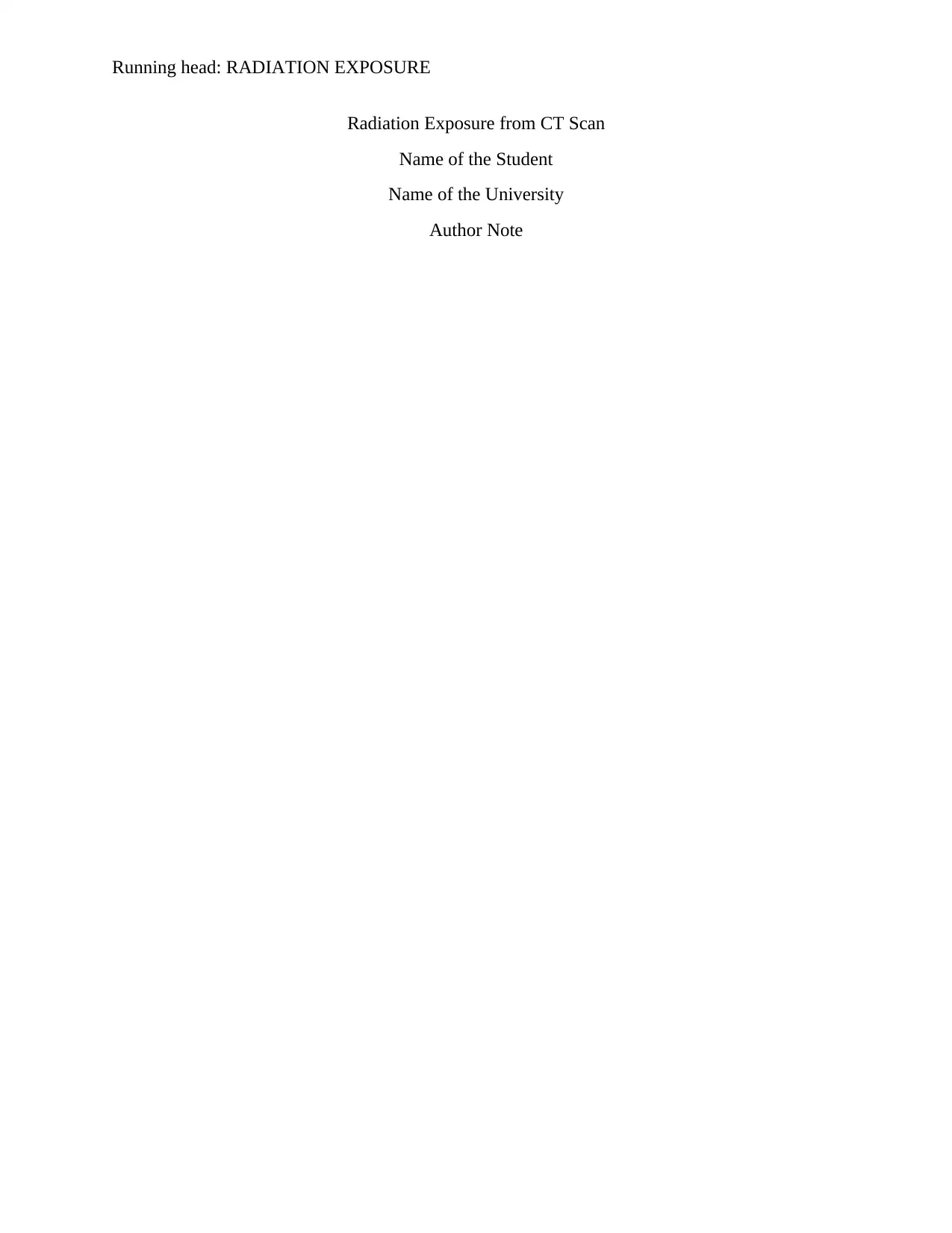
Running head: RADIATION EXPOSURE
Radiation Exposure from CT Scan
Name of the Student
Name of the University
Author Note
Radiation Exposure from CT Scan
Name of the Student
Name of the University
Author Note
Secure Best Marks with AI Grader
Need help grading? Try our AI Grader for instant feedback on your assignments.
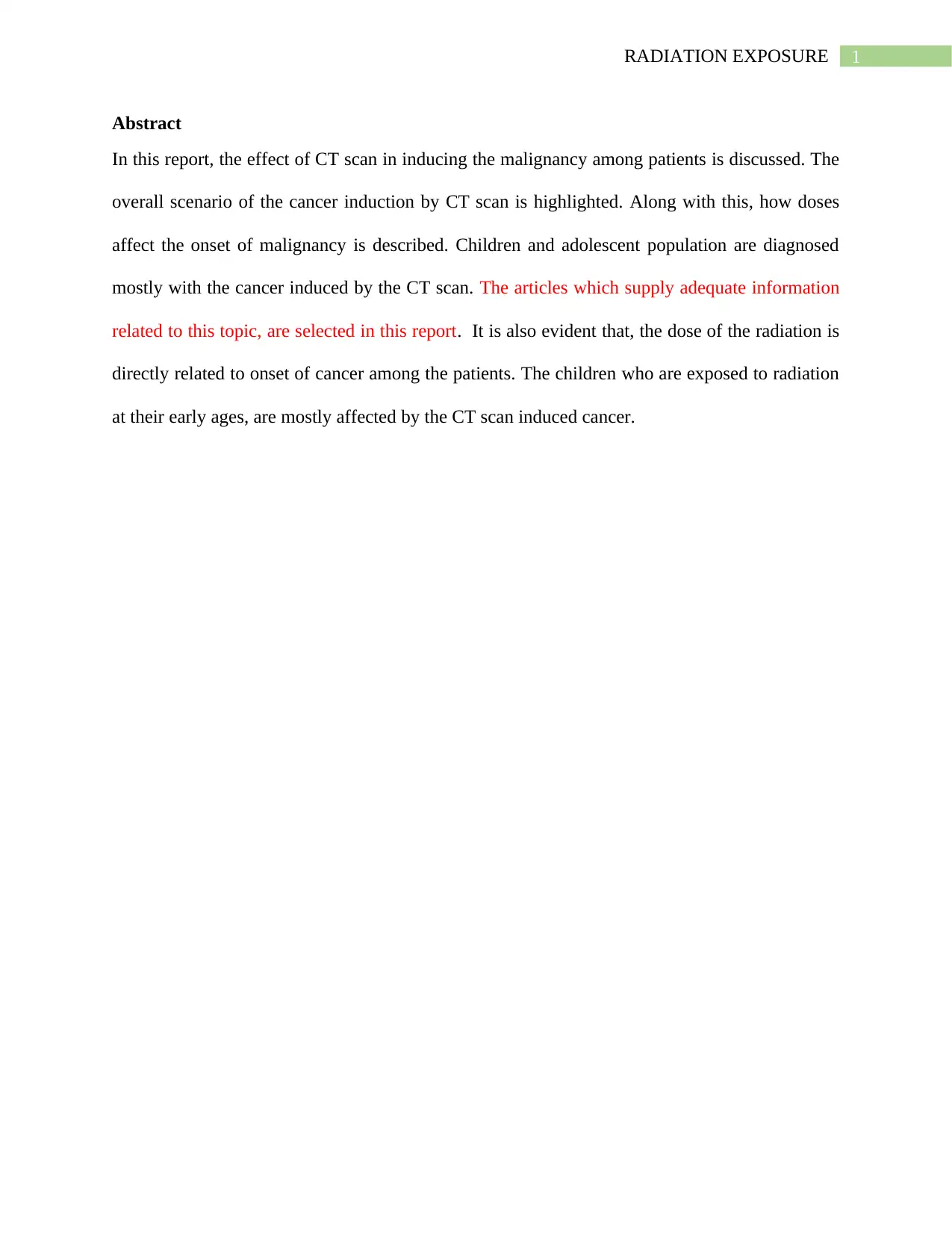
1RADIATION EXPOSURE
Abstract
In this report, the effect of CT scan in inducing the malignancy among patients is discussed. The
overall scenario of the cancer induction by CT scan is highlighted. Along with this, how doses
affect the onset of malignancy is described. Children and adolescent population are diagnosed
mostly with the cancer induced by the CT scan. The articles which supply adequate information
related to this topic, are selected in this report. It is also evident that, the dose of the radiation is
directly related to onset of cancer among the patients. The children who are exposed to radiation
at their early ages, are mostly affected by the CT scan induced cancer.
Abstract
In this report, the effect of CT scan in inducing the malignancy among patients is discussed. The
overall scenario of the cancer induction by CT scan is highlighted. Along with this, how doses
affect the onset of malignancy is described. Children and adolescent population are diagnosed
mostly with the cancer induced by the CT scan. The articles which supply adequate information
related to this topic, are selected in this report. It is also evident that, the dose of the radiation is
directly related to onset of cancer among the patients. The children who are exposed to radiation
at their early ages, are mostly affected by the CT scan induced cancer.
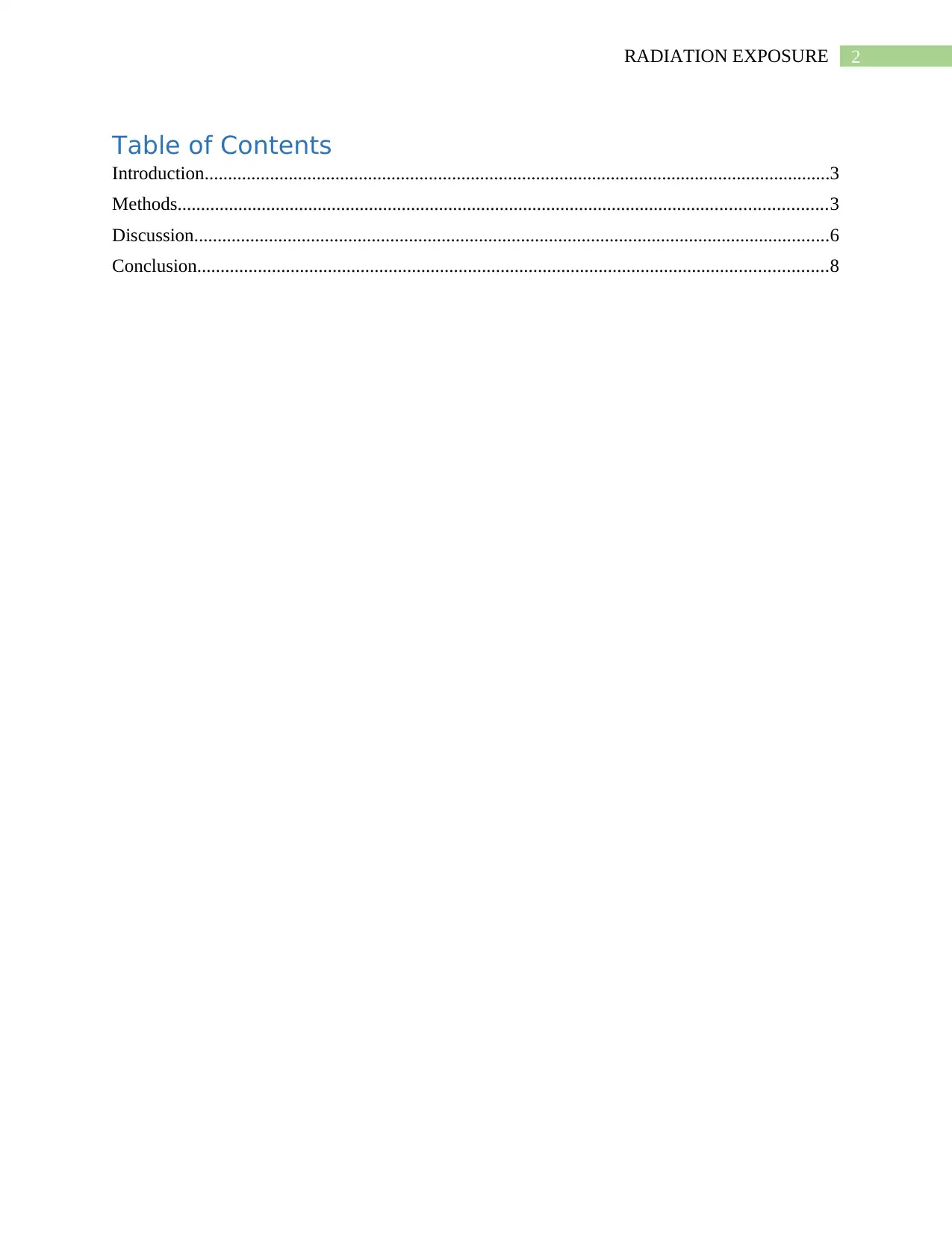
2RADIATION EXPOSURE
Table of Contents
Introduction......................................................................................................................................3
Methods...........................................................................................................................................3
Discussion........................................................................................................................................6
Conclusion.......................................................................................................................................8
Table of Contents
Introduction......................................................................................................................................3
Methods...........................................................................................................................................3
Discussion........................................................................................................................................6
Conclusion.......................................................................................................................................8
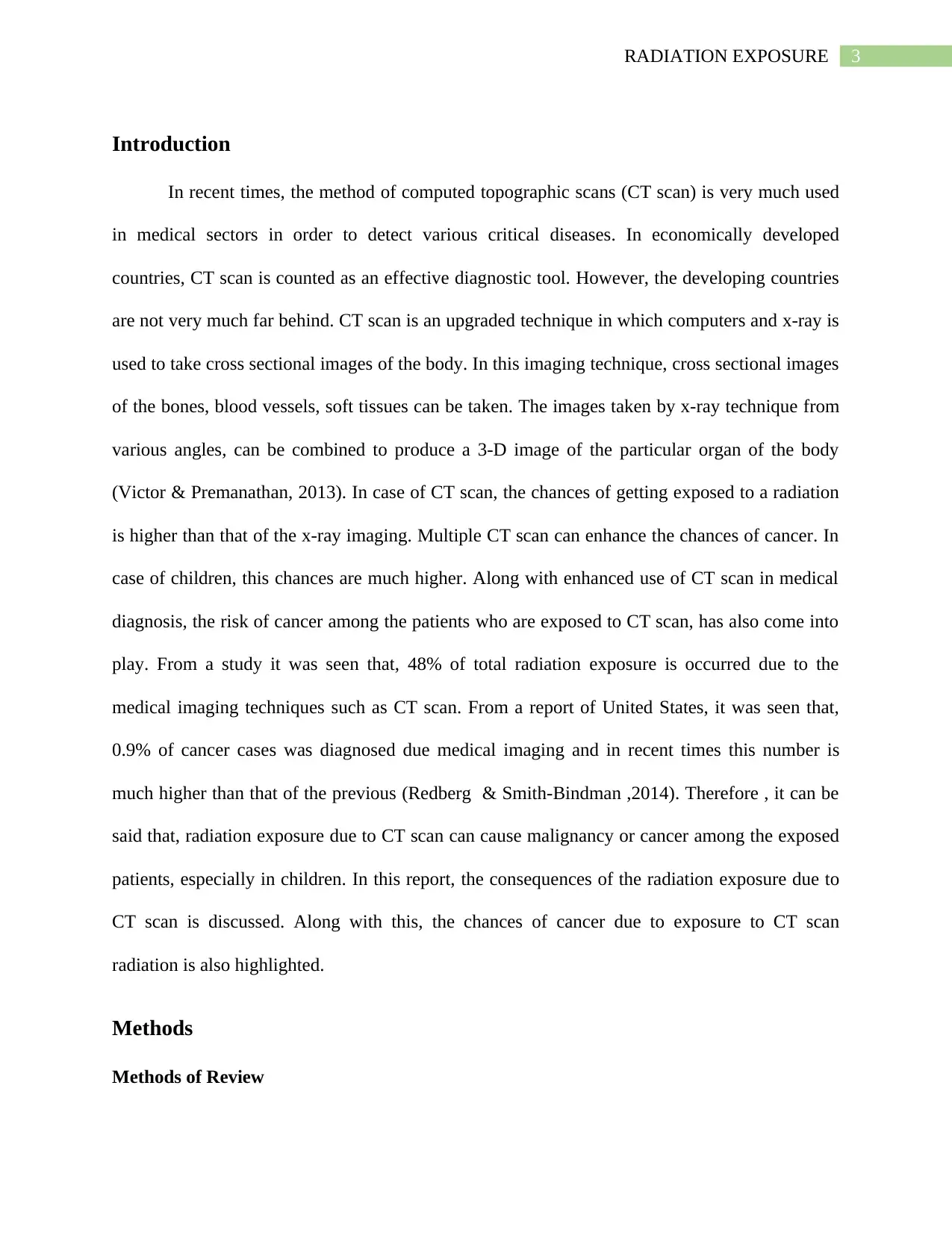
3RADIATION EXPOSURE
Introduction
In recent times, the method of computed topographic scans (CT scan) is very much used
in medical sectors in order to detect various critical diseases. In economically developed
countries, CT scan is counted as an effective diagnostic tool. However, the developing countries
are not very much far behind. CT scan is an upgraded technique in which computers and x-ray is
used to take cross sectional images of the body. In this imaging technique, cross sectional images
of the bones, blood vessels, soft tissues can be taken. The images taken by x-ray technique from
various angles, can be combined to produce a 3-D image of the particular organ of the body
(Victor & Premanathan, 2013). In case of CT scan, the chances of getting exposed to a radiation
is higher than that of the x-ray imaging. Multiple CT scan can enhance the chances of cancer. In
case of children, this chances are much higher. Along with enhanced use of CT scan in medical
diagnosis, the risk of cancer among the patients who are exposed to CT scan, has also come into
play. From a study it was seen that, 48% of total radiation exposure is occurred due to the
medical imaging techniques such as CT scan. From a report of United States, it was seen that,
0.9% of cancer cases was diagnosed due medical imaging and in recent times this number is
much higher than that of the previous (Redberg & Smith-Bindman ,2014). Therefore , it can be
said that, radiation exposure due to CT scan can cause malignancy or cancer among the exposed
patients, especially in children. In this report, the consequences of the radiation exposure due to
CT scan is discussed. Along with this, the chances of cancer due to exposure to CT scan
radiation is also highlighted.
Methods
Methods of Review
Introduction
In recent times, the method of computed topographic scans (CT scan) is very much used
in medical sectors in order to detect various critical diseases. In economically developed
countries, CT scan is counted as an effective diagnostic tool. However, the developing countries
are not very much far behind. CT scan is an upgraded technique in which computers and x-ray is
used to take cross sectional images of the body. In this imaging technique, cross sectional images
of the bones, blood vessels, soft tissues can be taken. The images taken by x-ray technique from
various angles, can be combined to produce a 3-D image of the particular organ of the body
(Victor & Premanathan, 2013). In case of CT scan, the chances of getting exposed to a radiation
is higher than that of the x-ray imaging. Multiple CT scan can enhance the chances of cancer. In
case of children, this chances are much higher. Along with enhanced use of CT scan in medical
diagnosis, the risk of cancer among the patients who are exposed to CT scan, has also come into
play. From a study it was seen that, 48% of total radiation exposure is occurred due to the
medical imaging techniques such as CT scan. From a report of United States, it was seen that,
0.9% of cancer cases was diagnosed due medical imaging and in recent times this number is
much higher than that of the previous (Redberg & Smith-Bindman ,2014). Therefore , it can be
said that, radiation exposure due to CT scan can cause malignancy or cancer among the exposed
patients, especially in children. In this report, the consequences of the radiation exposure due to
CT scan is discussed. Along with this, the chances of cancer due to exposure to CT scan
radiation is also highlighted.
Methods
Methods of Review
Secure Best Marks with AI Grader
Need help grading? Try our AI Grader for instant feedback on your assignments.
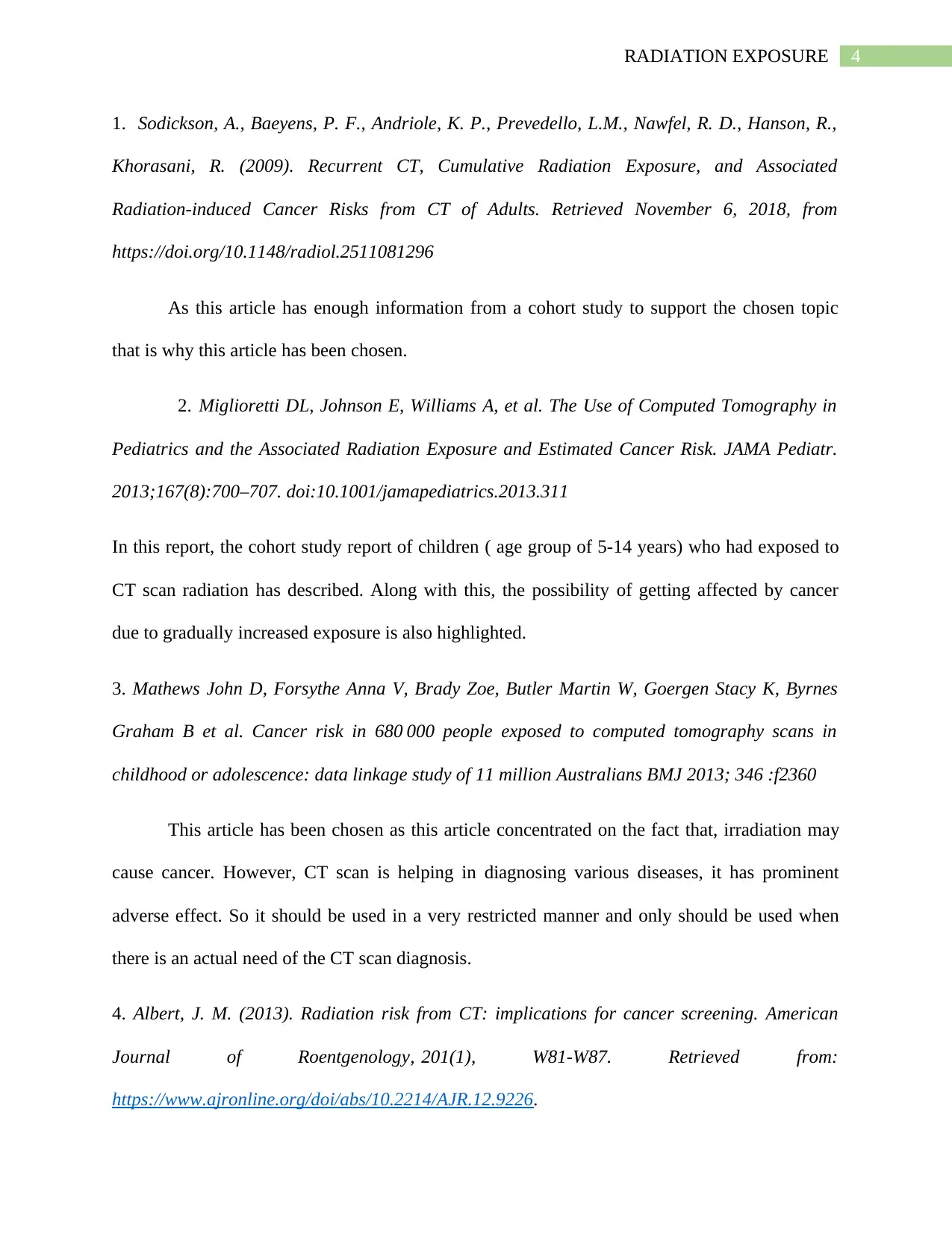
4RADIATION EXPOSURE
1. Sodickson, A., Baeyens, P. F., Andriole, K. P., Prevedello, L.M., Nawfel, R. D., Hanson, R.,
Khorasani, R. (2009). Recurrent CT, Cumulative Radiation Exposure, and Associated
Radiation-induced Cancer Risks from CT of Adults. Retrieved November 6, 2018, from
https://doi.org/10.1148/radiol.2511081296
As this article has enough information from a cohort study to support the chosen topic
that is why this article has been chosen.
2. Miglioretti DL, Johnson E, Williams A, et al. The Use of Computed Tomography in
Pediatrics and the Associated Radiation Exposure and Estimated Cancer Risk. JAMA Pediatr.
2013;167(8):700–707. doi:10.1001/jamapediatrics.2013.311
In this report, the cohort study report of children ( age group of 5-14 years) who had exposed to
CT scan radiation has described. Along with this, the possibility of getting affected by cancer
due to gradually increased exposure is also highlighted.
3. Mathews John D, Forsythe Anna V, Brady Zoe, Butler Martin W, Goergen Stacy K, Byrnes
Graham B et al. Cancer risk in 680 000 people exposed to computed tomography scans in
childhood or adolescence: data linkage study of 11 million Australians BMJ 2013; 346 :f2360
This article has been chosen as this article concentrated on the fact that, irradiation may
cause cancer. However, CT scan is helping in diagnosing various diseases, it has prominent
adverse effect. So it should be used in a very restricted manner and only should be used when
there is an actual need of the CT scan diagnosis.
4. Albert, J. M. (2013). Radiation risk from CT: implications for cancer screening. American
Journal of Roentgenology, 201(1), W81-W87. Retrieved from:
https://www.ajronline.org/doi/abs/10.2214/AJR.12.9226.
1. Sodickson, A., Baeyens, P. F., Andriole, K. P., Prevedello, L.M., Nawfel, R. D., Hanson, R.,
Khorasani, R. (2009). Recurrent CT, Cumulative Radiation Exposure, and Associated
Radiation-induced Cancer Risks from CT of Adults. Retrieved November 6, 2018, from
https://doi.org/10.1148/radiol.2511081296
As this article has enough information from a cohort study to support the chosen topic
that is why this article has been chosen.
2. Miglioretti DL, Johnson E, Williams A, et al. The Use of Computed Tomography in
Pediatrics and the Associated Radiation Exposure and Estimated Cancer Risk. JAMA Pediatr.
2013;167(8):700–707. doi:10.1001/jamapediatrics.2013.311
In this report, the cohort study report of children ( age group of 5-14 years) who had exposed to
CT scan radiation has described. Along with this, the possibility of getting affected by cancer
due to gradually increased exposure is also highlighted.
3. Mathews John D, Forsythe Anna V, Brady Zoe, Butler Martin W, Goergen Stacy K, Byrnes
Graham B et al. Cancer risk in 680 000 people exposed to computed tomography scans in
childhood or adolescence: data linkage study of 11 million Australians BMJ 2013; 346 :f2360
This article has been chosen as this article concentrated on the fact that, irradiation may
cause cancer. However, CT scan is helping in diagnosing various diseases, it has prominent
adverse effect. So it should be used in a very restricted manner and only should be used when
there is an actual need of the CT scan diagnosis.
4. Albert, J. M. (2013). Radiation risk from CT: implications for cancer screening. American
Journal of Roentgenology, 201(1), W81-W87. Retrieved from:
https://www.ajronline.org/doi/abs/10.2214/AJR.12.9226.
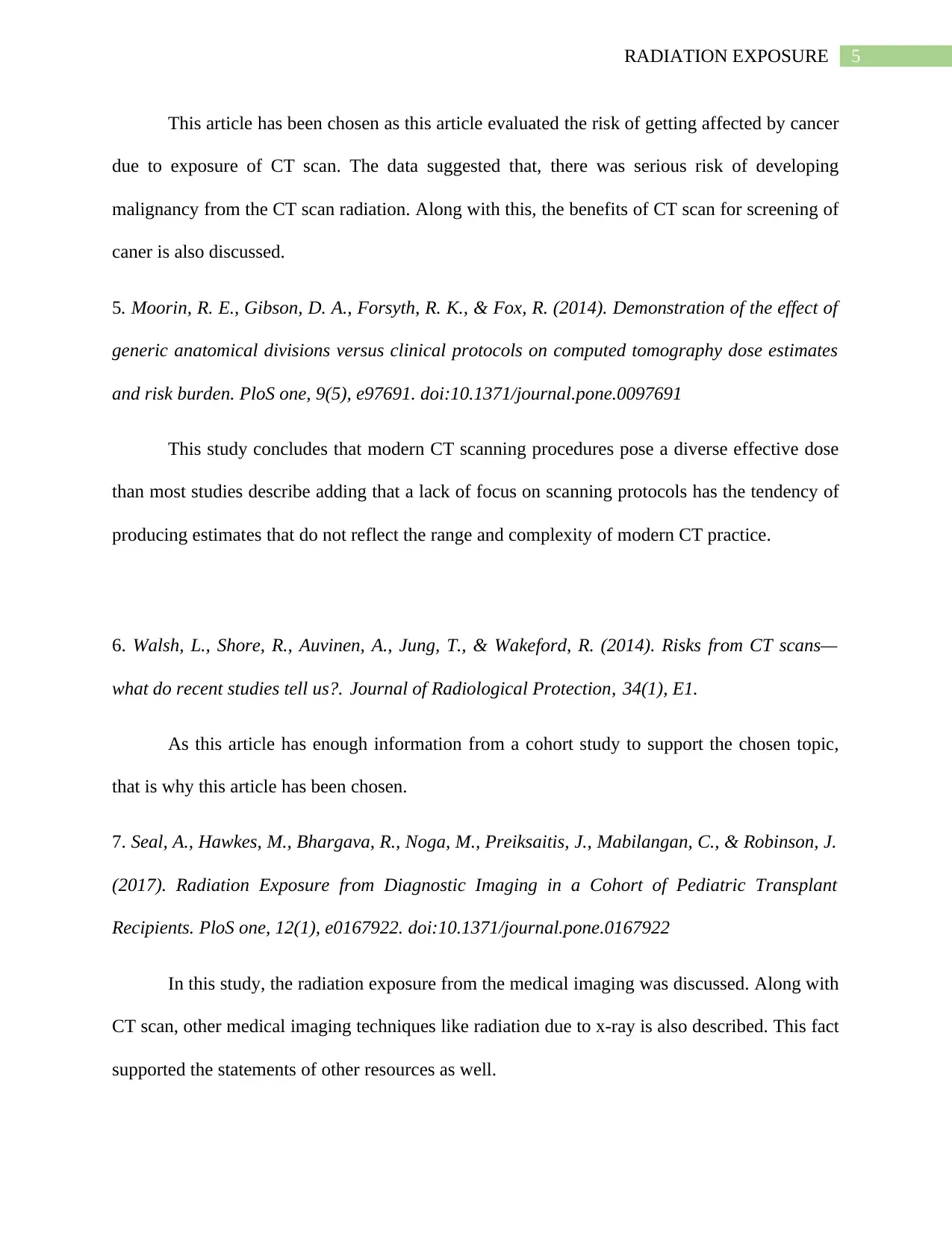
5RADIATION EXPOSURE
This article has been chosen as this article evaluated the risk of getting affected by cancer
due to exposure of CT scan. The data suggested that, there was serious risk of developing
malignancy from the CT scan radiation. Along with this, the benefits of CT scan for screening of
caner is also discussed.
5. Moorin, R. E., Gibson, D. A., Forsyth, R. K., & Fox, R. (2014). Demonstration of the effect of
generic anatomical divisions versus clinical protocols on computed tomography dose estimates
and risk burden. PloS one, 9(5), e97691. doi:10.1371/journal.pone.0097691
This study concludes that modern CT scanning procedures pose a diverse effective dose
than most studies describe adding that a lack of focus on scanning protocols has the tendency of
producing estimates that do not reflect the range and complexity of modern CT practice.
6. Walsh, L., Shore, R., Auvinen, A., Jung, T., & Wakeford, R. (2014). Risks from CT scans—
what do recent studies tell us?. Journal of Radiological Protection, 34(1), E1.
As this article has enough information from a cohort study to support the chosen topic,
that is why this article has been chosen.
7. Seal, A., Hawkes, M., Bhargava, R., Noga, M., Preiksaitis, J., Mabilangan, C., & Robinson, J.
(2017). Radiation Exposure from Diagnostic Imaging in a Cohort of Pediatric Transplant
Recipients. PloS one, 12(1), e0167922. doi:10.1371/journal.pone.0167922
In this study, the radiation exposure from the medical imaging was discussed. Along with
CT scan, other medical imaging techniques like radiation due to x-ray is also described. This fact
supported the statements of other resources as well.
This article has been chosen as this article evaluated the risk of getting affected by cancer
due to exposure of CT scan. The data suggested that, there was serious risk of developing
malignancy from the CT scan radiation. Along with this, the benefits of CT scan for screening of
caner is also discussed.
5. Moorin, R. E., Gibson, D. A., Forsyth, R. K., & Fox, R. (2014). Demonstration of the effect of
generic anatomical divisions versus clinical protocols on computed tomography dose estimates
and risk burden. PloS one, 9(5), e97691. doi:10.1371/journal.pone.0097691
This study concludes that modern CT scanning procedures pose a diverse effective dose
than most studies describe adding that a lack of focus on scanning protocols has the tendency of
producing estimates that do not reflect the range and complexity of modern CT practice.
6. Walsh, L., Shore, R., Auvinen, A., Jung, T., & Wakeford, R. (2014). Risks from CT scans—
what do recent studies tell us?. Journal of Radiological Protection, 34(1), E1.
As this article has enough information from a cohort study to support the chosen topic,
that is why this article has been chosen.
7. Seal, A., Hawkes, M., Bhargava, R., Noga, M., Preiksaitis, J., Mabilangan, C., & Robinson, J.
(2017). Radiation Exposure from Diagnostic Imaging in a Cohort of Pediatric Transplant
Recipients. PloS one, 12(1), e0167922. doi:10.1371/journal.pone.0167922
In this study, the radiation exposure from the medical imaging was discussed. Along with
CT scan, other medical imaging techniques like radiation due to x-ray is also described. This fact
supported the statements of other resources as well.
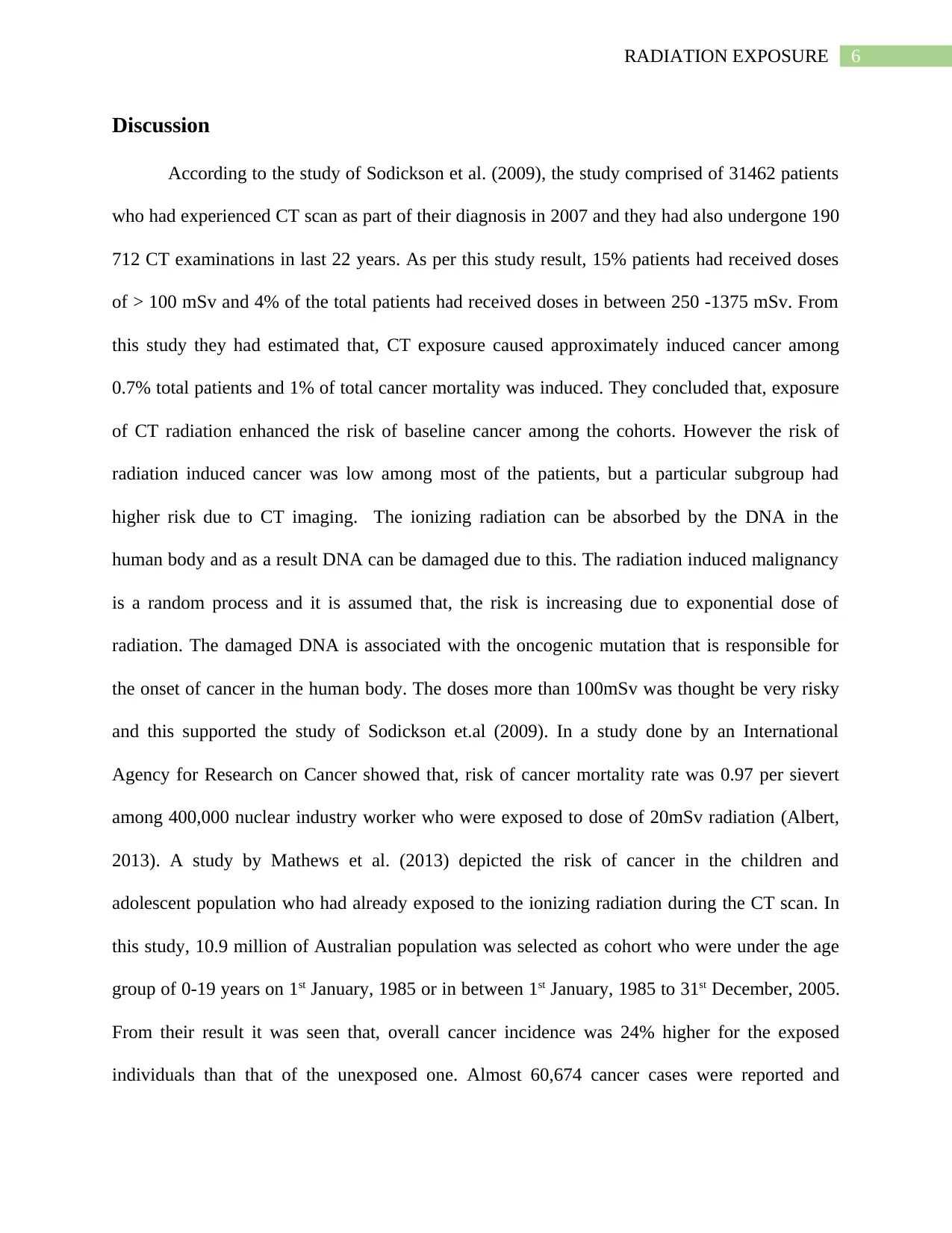
6RADIATION EXPOSURE
Discussion
According to the study of Sodickson et al. (2009), the study comprised of 31462 patients
who had experienced CT scan as part of their diagnosis in 2007 and they had also undergone 190
712 CT examinations in last 22 years. As per this study result, 15% patients had received doses
of > 100 mSv and 4% of the total patients had received doses in between 250 -1375 mSv. From
this study they had estimated that, CT exposure caused approximately induced cancer among
0.7% total patients and 1% of total cancer mortality was induced. They concluded that, exposure
of CT radiation enhanced the risk of baseline cancer among the cohorts. However the risk of
radiation induced cancer was low among most of the patients, but a particular subgroup had
higher risk due to CT imaging. The ionizing radiation can be absorbed by the DNA in the
human body and as a result DNA can be damaged due to this. The radiation induced malignancy
is a random process and it is assumed that, the risk is increasing due to exponential dose of
radiation. The damaged DNA is associated with the oncogenic mutation that is responsible for
the onset of cancer in the human body. The doses more than 100mSv was thought be very risky
and this supported the study of Sodickson et.al (2009). In a study done by an International
Agency for Research on Cancer showed that, risk of cancer mortality rate was 0.97 per sievert
among 400,000 nuclear industry worker who were exposed to dose of 20mSv radiation (Albert,
2013). A study by Mathews et al. (2013) depicted the risk of cancer in the children and
adolescent population who had already exposed to the ionizing radiation during the CT scan. In
this study, 10.9 million of Australian population was selected as cohort who were under the age
group of 0-19 years on 1st January, 1985 or in between 1st January, 1985 to 31st December, 2005.
From their result it was seen that, overall cancer incidence was 24% higher for the exposed
individuals than that of the unexposed one. Almost 60,674 cancer cases were reported and
Discussion
According to the study of Sodickson et al. (2009), the study comprised of 31462 patients
who had experienced CT scan as part of their diagnosis in 2007 and they had also undergone 190
712 CT examinations in last 22 years. As per this study result, 15% patients had received doses
of > 100 mSv and 4% of the total patients had received doses in between 250 -1375 mSv. From
this study they had estimated that, CT exposure caused approximately induced cancer among
0.7% total patients and 1% of total cancer mortality was induced. They concluded that, exposure
of CT radiation enhanced the risk of baseline cancer among the cohorts. However the risk of
radiation induced cancer was low among most of the patients, but a particular subgroup had
higher risk due to CT imaging. The ionizing radiation can be absorbed by the DNA in the
human body and as a result DNA can be damaged due to this. The radiation induced malignancy
is a random process and it is assumed that, the risk is increasing due to exponential dose of
radiation. The damaged DNA is associated with the oncogenic mutation that is responsible for
the onset of cancer in the human body. The doses more than 100mSv was thought be very risky
and this supported the study of Sodickson et.al (2009). In a study done by an International
Agency for Research on Cancer showed that, risk of cancer mortality rate was 0.97 per sievert
among 400,000 nuclear industry worker who were exposed to dose of 20mSv radiation (Albert,
2013). A study by Mathews et al. (2013) depicted the risk of cancer in the children and
adolescent population who had already exposed to the ionizing radiation during the CT scan. In
this study, 10.9 million of Australian population was selected as cohort who were under the age
group of 0-19 years on 1st January, 1985 or in between 1st January, 1985 to 31st December, 2005.
From their result it was seen that, overall cancer incidence was 24% higher for the exposed
individuals than that of the unexposed one. Almost 60,674 cancer cases were reported and
Paraphrase This Document
Need a fresh take? Get an instant paraphrase of this document with our AI Paraphraser
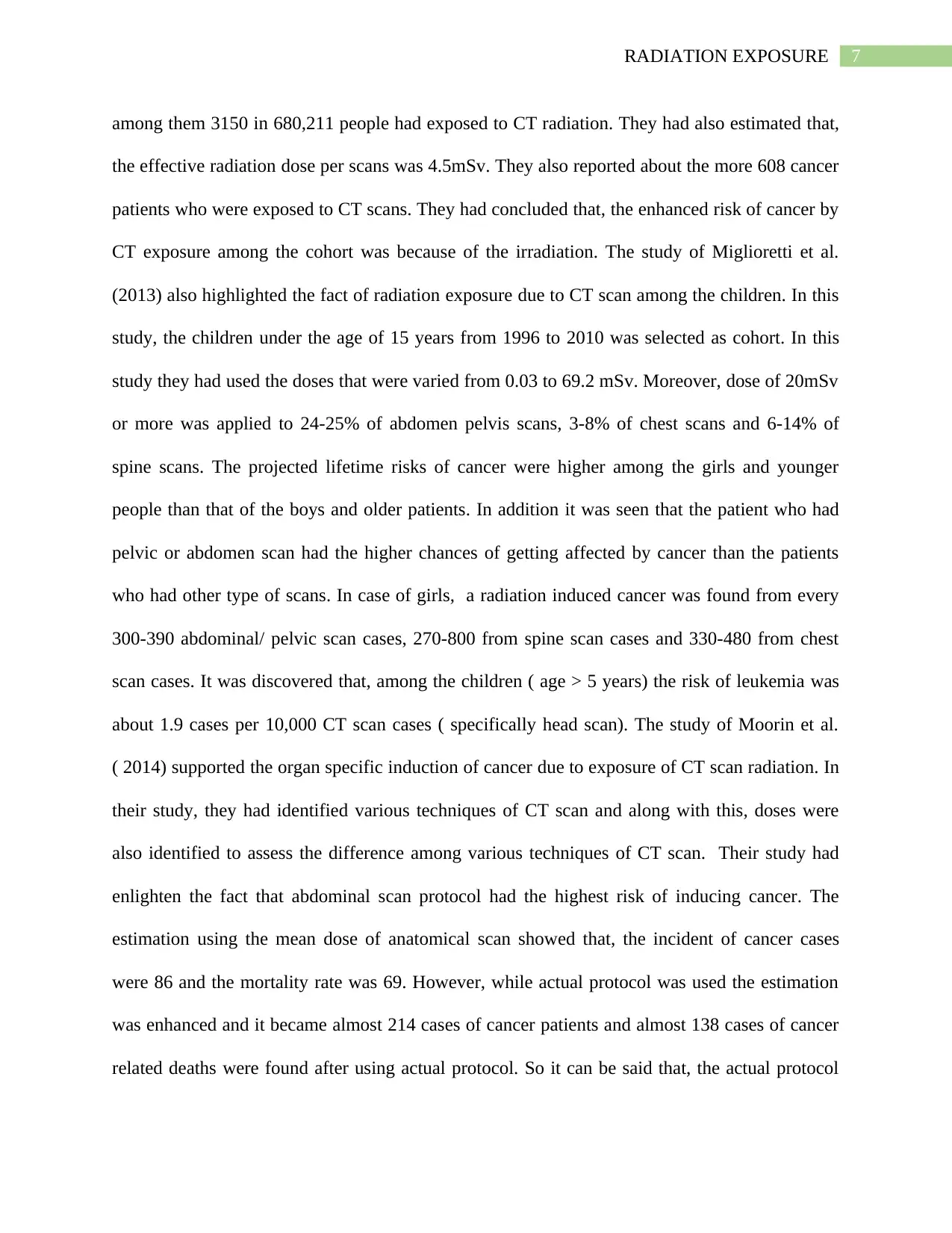
7RADIATION EXPOSURE
among them 3150 in 680,211 people had exposed to CT radiation. They had also estimated that,
the effective radiation dose per scans was 4.5mSv. They also reported about the more 608 cancer
patients who were exposed to CT scans. They had concluded that, the enhanced risk of cancer by
CT exposure among the cohort was because of the irradiation. The study of Miglioretti et al.
(2013) also highlighted the fact of radiation exposure due to CT scan among the children. In this
study, the children under the age of 15 years from 1996 to 2010 was selected as cohort. In this
study they had used the doses that were varied from 0.03 to 69.2 mSv. Moreover, dose of 20mSv
or more was applied to 24-25% of abdomen pelvis scans, 3-8% of chest scans and 6-14% of
spine scans. The projected lifetime risks of cancer were higher among the girls and younger
people than that of the boys and older patients. In addition it was seen that the patient who had
pelvic or abdomen scan had the higher chances of getting affected by cancer than the patients
who had other type of scans. In case of girls, a radiation induced cancer was found from every
300-390 abdominal/ pelvic scan cases, 270-800 from spine scan cases and 330-480 from chest
scan cases. It was discovered that, among the children ( age > 5 years) the risk of leukemia was
about 1.9 cases per 10,000 CT scan cases ( specifically head scan). The study of Moorin et al.
( 2014) supported the organ specific induction of cancer due to exposure of CT scan radiation. In
their study, they had identified various techniques of CT scan and along with this, doses were
also identified to assess the difference among various techniques of CT scan. Their study had
enlighten the fact that abdominal scan protocol had the highest risk of inducing cancer. The
estimation using the mean dose of anatomical scan showed that, the incident of cancer cases
were 86 and the mortality rate was 69. However, while actual protocol was used the estimation
was enhanced and it became almost 214 cases of cancer patients and almost 138 cases of cancer
related deaths were found after using actual protocol. So it can be said that, the actual protocol
among them 3150 in 680,211 people had exposed to CT radiation. They had also estimated that,
the effective radiation dose per scans was 4.5mSv. They also reported about the more 608 cancer
patients who were exposed to CT scans. They had concluded that, the enhanced risk of cancer by
CT exposure among the cohort was because of the irradiation. The study of Miglioretti et al.
(2013) also highlighted the fact of radiation exposure due to CT scan among the children. In this
study, the children under the age of 15 years from 1996 to 2010 was selected as cohort. In this
study they had used the doses that were varied from 0.03 to 69.2 mSv. Moreover, dose of 20mSv
or more was applied to 24-25% of abdomen pelvis scans, 3-8% of chest scans and 6-14% of
spine scans. The projected lifetime risks of cancer were higher among the girls and younger
people than that of the boys and older patients. In addition it was seen that the patient who had
pelvic or abdomen scan had the higher chances of getting affected by cancer than the patients
who had other type of scans. In case of girls, a radiation induced cancer was found from every
300-390 abdominal/ pelvic scan cases, 270-800 from spine scan cases and 330-480 from chest
scan cases. It was discovered that, among the children ( age > 5 years) the risk of leukemia was
about 1.9 cases per 10,000 CT scan cases ( specifically head scan). The study of Moorin et al.
( 2014) supported the organ specific induction of cancer due to exposure of CT scan radiation. In
their study, they had identified various techniques of CT scan and along with this, doses were
also identified to assess the difference among various techniques of CT scan. Their study had
enlighten the fact that abdominal scan protocol had the highest risk of inducing cancer. The
estimation using the mean dose of anatomical scan showed that, the incident of cancer cases
were 86 and the mortality rate was 69. However, while actual protocol was used the estimation
was enhanced and it became almost 214 cases of cancer patients and almost 138 cases of cancer
related deaths were found after using actual protocol. So it can be said that, the actual protocol
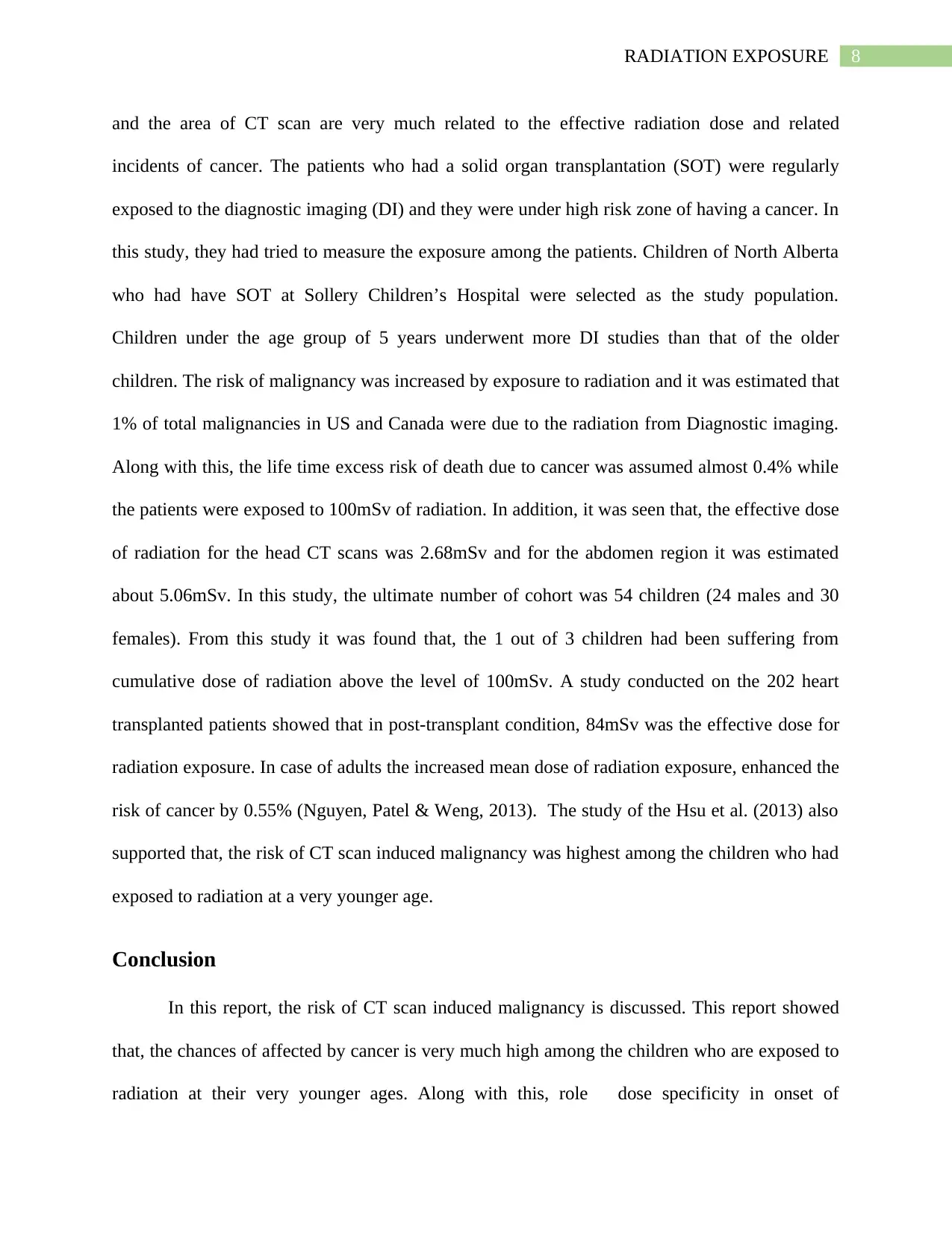
8RADIATION EXPOSURE
and the area of CT scan are very much related to the effective radiation dose and related
incidents of cancer. The patients who had a solid organ transplantation (SOT) were regularly
exposed to the diagnostic imaging (DI) and they were under high risk zone of having a cancer. In
this study, they had tried to measure the exposure among the patients. Children of North Alberta
who had have SOT at Sollery Children’s Hospital were selected as the study population.
Children under the age group of 5 years underwent more DI studies than that of the older
children. The risk of malignancy was increased by exposure to radiation and it was estimated that
1% of total malignancies in US and Canada were due to the radiation from Diagnostic imaging.
Along with this, the life time excess risk of death due to cancer was assumed almost 0.4% while
the patients were exposed to 100mSv of radiation. In addition, it was seen that, the effective dose
of radiation for the head CT scans was 2.68mSv and for the abdomen region it was estimated
about 5.06mSv. In this study, the ultimate number of cohort was 54 children (24 males and 30
females). From this study it was found that, the 1 out of 3 children had been suffering from
cumulative dose of radiation above the level of 100mSv. A study conducted on the 202 heart
transplanted patients showed that in post-transplant condition, 84mSv was the effective dose for
radiation exposure. In case of adults the increased mean dose of radiation exposure, enhanced the
risk of cancer by 0.55% (Nguyen, Patel & Weng, 2013). The study of the Hsu et al. (2013) also
supported that, the risk of CT scan induced malignancy was highest among the children who had
exposed to radiation at a very younger age.
Conclusion
In this report, the risk of CT scan induced malignancy is discussed. This report showed
that, the chances of affected by cancer is very much high among the children who are exposed to
radiation at their very younger ages. Along with this, role dose specificity in onset of
and the area of CT scan are very much related to the effective radiation dose and related
incidents of cancer. The patients who had a solid organ transplantation (SOT) were regularly
exposed to the diagnostic imaging (DI) and they were under high risk zone of having a cancer. In
this study, they had tried to measure the exposure among the patients. Children of North Alberta
who had have SOT at Sollery Children’s Hospital were selected as the study population.
Children under the age group of 5 years underwent more DI studies than that of the older
children. The risk of malignancy was increased by exposure to radiation and it was estimated that
1% of total malignancies in US and Canada were due to the radiation from Diagnostic imaging.
Along with this, the life time excess risk of death due to cancer was assumed almost 0.4% while
the patients were exposed to 100mSv of radiation. In addition, it was seen that, the effective dose
of radiation for the head CT scans was 2.68mSv and for the abdomen region it was estimated
about 5.06mSv. In this study, the ultimate number of cohort was 54 children (24 males and 30
females). From this study it was found that, the 1 out of 3 children had been suffering from
cumulative dose of radiation above the level of 100mSv. A study conducted on the 202 heart
transplanted patients showed that in post-transplant condition, 84mSv was the effective dose for
radiation exposure. In case of adults the increased mean dose of radiation exposure, enhanced the
risk of cancer by 0.55% (Nguyen, Patel & Weng, 2013). The study of the Hsu et al. (2013) also
supported that, the risk of CT scan induced malignancy was highest among the children who had
exposed to radiation at a very younger age.
Conclusion
In this report, the risk of CT scan induced malignancy is discussed. This report showed
that, the chances of affected by cancer is very much high among the children who are exposed to
radiation at their very younger ages. Along with this, role dose specificity in onset of
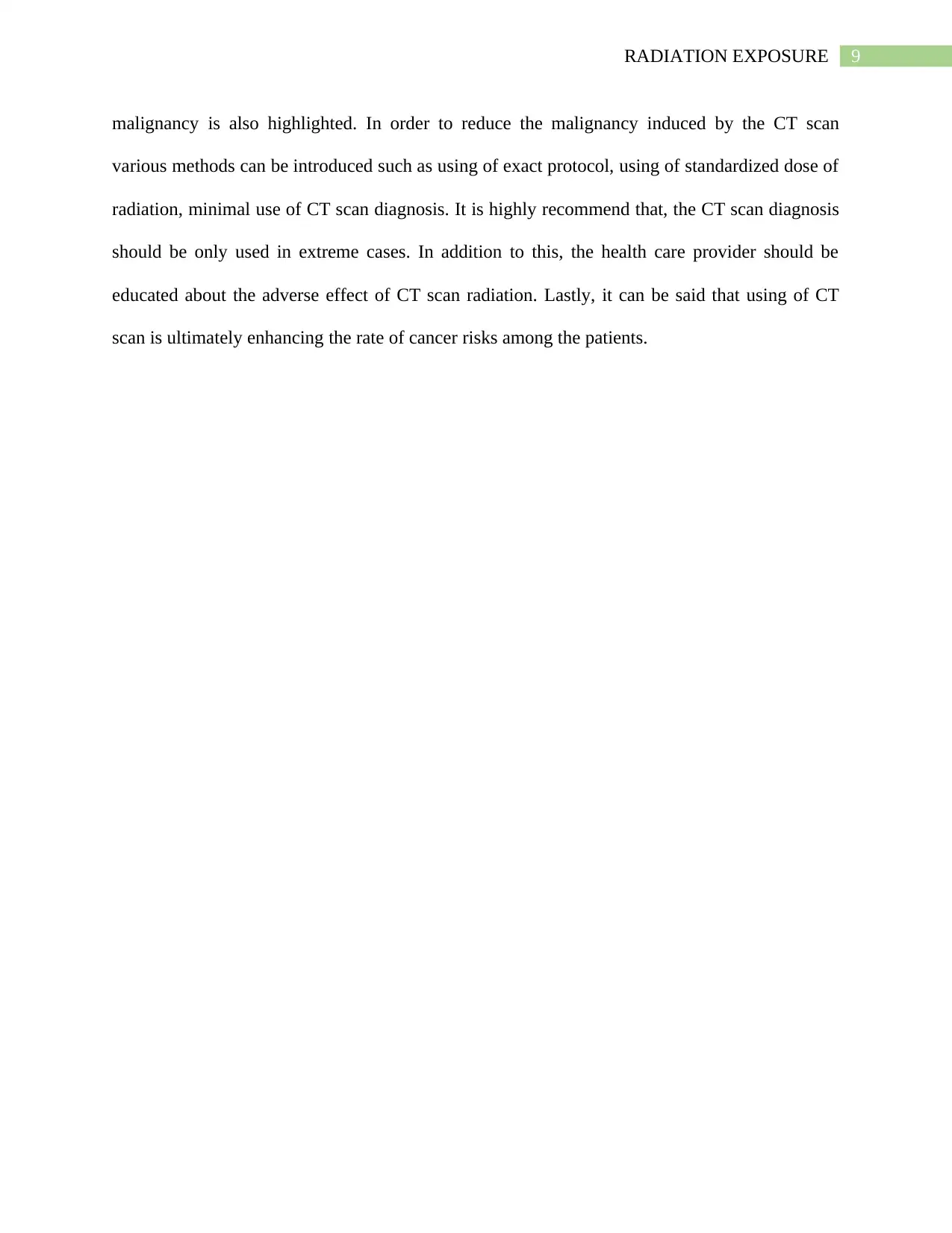
9RADIATION EXPOSURE
malignancy is also highlighted. In order to reduce the malignancy induced by the CT scan
various methods can be introduced such as using of exact protocol, using of standardized dose of
radiation, minimal use of CT scan diagnosis. It is highly recommend that, the CT scan diagnosis
should be only used in extreme cases. In addition to this, the health care provider should be
educated about the adverse effect of CT scan radiation. Lastly, it can be said that using of CT
scan is ultimately enhancing the rate of cancer risks among the patients.
malignancy is also highlighted. In order to reduce the malignancy induced by the CT scan
various methods can be introduced such as using of exact protocol, using of standardized dose of
radiation, minimal use of CT scan diagnosis. It is highly recommend that, the CT scan diagnosis
should be only used in extreme cases. In addition to this, the health care provider should be
educated about the adverse effect of CT scan radiation. Lastly, it can be said that using of CT
scan is ultimately enhancing the rate of cancer risks among the patients.
Secure Best Marks with AI Grader
Need help grading? Try our AI Grader for instant feedback on your assignments.
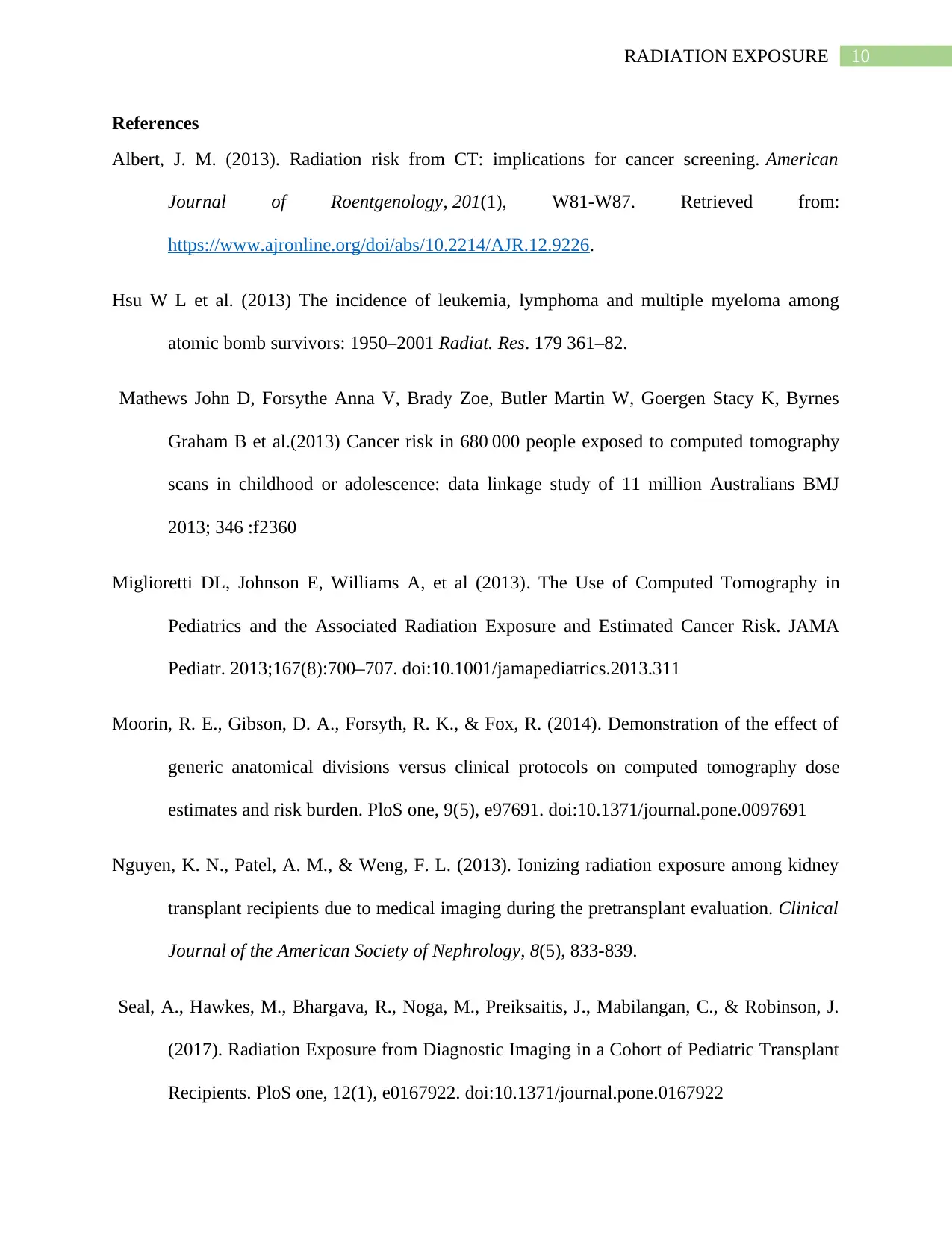
10RADIATION EXPOSURE
References
Albert, J. M. (2013). Radiation risk from CT: implications for cancer screening. American
Journal of Roentgenology, 201(1), W81-W87. Retrieved from:
https://www.ajronline.org/doi/abs/10.2214/AJR.12.9226.
Hsu W L et al. (2013) The incidence of leukemia, lymphoma and multiple myeloma among
atomic bomb survivors: 1950–2001 Radiat. Res. 179 361–82.
Mathews John D, Forsythe Anna V, Brady Zoe, Butler Martin W, Goergen Stacy K, Byrnes
Graham B et al.(2013) Cancer risk in 680 000 people exposed to computed tomography
scans in childhood or adolescence: data linkage study of 11 million Australians BMJ
2013; 346 :f2360
Miglioretti DL, Johnson E, Williams A, et al (2013). The Use of Computed Tomography in
Pediatrics and the Associated Radiation Exposure and Estimated Cancer Risk. JAMA
Pediatr. 2013;167(8):700–707. doi:10.1001/jamapediatrics.2013.311
Moorin, R. E., Gibson, D. A., Forsyth, R. K., & Fox, R. (2014). Demonstration of the effect of
generic anatomical divisions versus clinical protocols on computed tomography dose
estimates and risk burden. PloS one, 9(5), e97691. doi:10.1371/journal.pone.0097691
Nguyen, K. N., Patel, A. M., & Weng, F. L. (2013). Ionizing radiation exposure among kidney
transplant recipients due to medical imaging during the pretransplant evaluation. Clinical
Journal of the American Society of Nephrology, 8(5), 833-839.
Seal, A., Hawkes, M., Bhargava, R., Noga, M., Preiksaitis, J., Mabilangan, C., & Robinson, J.
(2017). Radiation Exposure from Diagnostic Imaging in a Cohort of Pediatric Transplant
Recipients. PloS one, 12(1), e0167922. doi:10.1371/journal.pone.0167922
References
Albert, J. M. (2013). Radiation risk from CT: implications for cancer screening. American
Journal of Roentgenology, 201(1), W81-W87. Retrieved from:
https://www.ajronline.org/doi/abs/10.2214/AJR.12.9226.
Hsu W L et al. (2013) The incidence of leukemia, lymphoma and multiple myeloma among
atomic bomb survivors: 1950–2001 Radiat. Res. 179 361–82.
Mathews John D, Forsythe Anna V, Brady Zoe, Butler Martin W, Goergen Stacy K, Byrnes
Graham B et al.(2013) Cancer risk in 680 000 people exposed to computed tomography
scans in childhood or adolescence: data linkage study of 11 million Australians BMJ
2013; 346 :f2360
Miglioretti DL, Johnson E, Williams A, et al (2013). The Use of Computed Tomography in
Pediatrics and the Associated Radiation Exposure and Estimated Cancer Risk. JAMA
Pediatr. 2013;167(8):700–707. doi:10.1001/jamapediatrics.2013.311
Moorin, R. E., Gibson, D. A., Forsyth, R. K., & Fox, R. (2014). Demonstration of the effect of
generic anatomical divisions versus clinical protocols on computed tomography dose
estimates and risk burden. PloS one, 9(5), e97691. doi:10.1371/journal.pone.0097691
Nguyen, K. N., Patel, A. M., & Weng, F. L. (2013). Ionizing radiation exposure among kidney
transplant recipients due to medical imaging during the pretransplant evaluation. Clinical
Journal of the American Society of Nephrology, 8(5), 833-839.
Seal, A., Hawkes, M., Bhargava, R., Noga, M., Preiksaitis, J., Mabilangan, C., & Robinson, J.
(2017). Radiation Exposure from Diagnostic Imaging in a Cohort of Pediatric Transplant
Recipients. PloS one, 12(1), e0167922. doi:10.1371/journal.pone.0167922
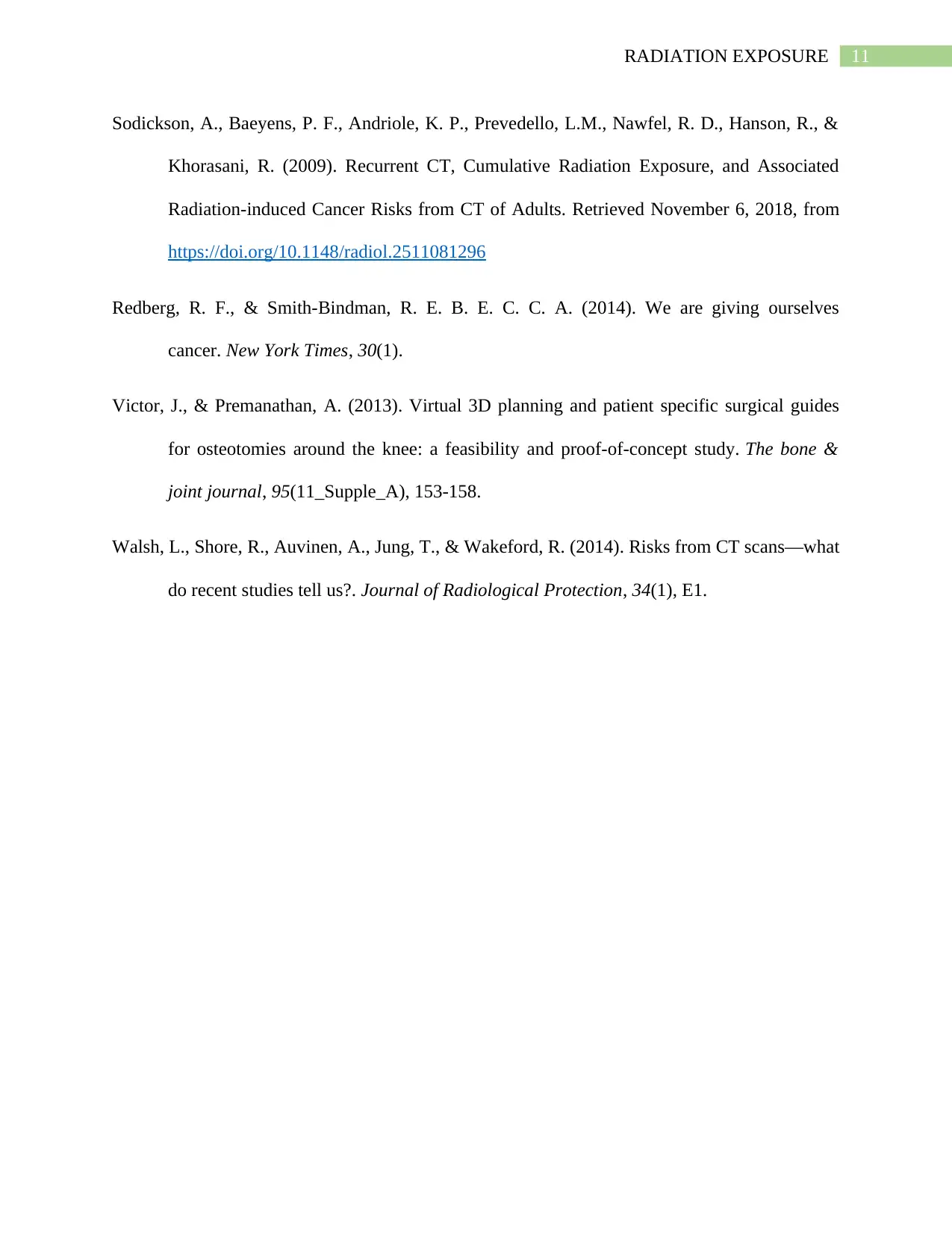
11RADIATION EXPOSURE
Sodickson, A., Baeyens, P. F., Andriole, K. P., Prevedello, L.M., Nawfel, R. D., Hanson, R., &
Khorasani, R. (2009). Recurrent CT, Cumulative Radiation Exposure, and Associated
Radiation-induced Cancer Risks from CT of Adults. Retrieved November 6, 2018, from
https://doi.org/10.1148/radiol.2511081296
Redberg, R. F., & Smith-Bindman, R. E. B. E. C. C. A. (2014). We are giving ourselves
cancer. New York Times, 30(1).
Victor, J., & Premanathan, A. (2013). Virtual 3D planning and patient specific surgical guides
for osteotomies around the knee: a feasibility and proof-of-concept study. The bone &
joint journal, 95(11_Supple_A), 153-158.
Walsh, L., Shore, R., Auvinen, A., Jung, T., & Wakeford, R. (2014). Risks from CT scans—what
do recent studies tell us?. Journal of Radiological Protection, 34(1), E1.
Sodickson, A., Baeyens, P. F., Andriole, K. P., Prevedello, L.M., Nawfel, R. D., Hanson, R., &
Khorasani, R. (2009). Recurrent CT, Cumulative Radiation Exposure, and Associated
Radiation-induced Cancer Risks from CT of Adults. Retrieved November 6, 2018, from
https://doi.org/10.1148/radiol.2511081296
Redberg, R. F., & Smith-Bindman, R. E. B. E. C. C. A. (2014). We are giving ourselves
cancer. New York Times, 30(1).
Victor, J., & Premanathan, A. (2013). Virtual 3D planning and patient specific surgical guides
for osteotomies around the knee: a feasibility and proof-of-concept study. The bone &
joint journal, 95(11_Supple_A), 153-158.
Walsh, L., Shore, R., Auvinen, A., Jung, T., & Wakeford, R. (2014). Risks from CT scans—what
do recent studies tell us?. Journal of Radiological Protection, 34(1), E1.
1 out of 12
Related Documents
Your All-in-One AI-Powered Toolkit for Academic Success.
+13062052269
info@desklib.com
Available 24*7 on WhatsApp / Email
![[object Object]](/_next/static/media/star-bottom.7253800d.svg)
Unlock your academic potential
© 2024 | Zucol Services PVT LTD | All rights reserved.





